No, it’s not a Supreme Court case, but it does raise an interesting debate.
Before traveling to Montana and Wyoming, I hadn’t the slightest clue what a pictograph or a petroglyph was. But as a resident of Chicago, I knew damn well what graffiti was. After a couple self-guided tours, I now like to think of myself as somewhat of a pictograph/petroglyph expert.
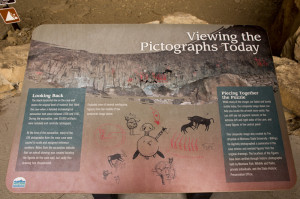 The Cliff’s Notes, you ask? Petroglyphs are carvings and pictographs are paintings.
The Cliff’s Notes, you ask? Petroglyphs are carvings and pictographs are paintings.
Although they’re both types of rock art, petroglyphs are carved into an exposed rock surface and pictographs are painted onto those surfaces. I saw my first pictographs at Pictograph Cave State Park in Billings, Montana. Some prehistoric hunters used to camp in this cave and left us something to remember them by. More than 100 pictographs and artifacts have been found in the cave, the oldest being 2,000+ years old.
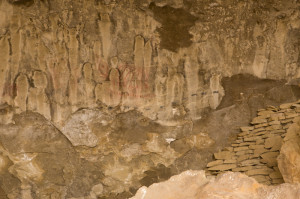 The state park is quite small compared to most in the area and has just one hiking trail. However, the lack of trails is made up for by the abundance of educational plaques along the way. You’ll need to pay the friendly ranger $5 if your car has an out-of-state plate before making your way up the well-paved, wheelchair accessible trail.
The state park is quite small compared to most in the area and has just one hiking trail. However, the lack of trails is made up for by the abundance of educational plaques along the way. You’ll need to pay the friendly ranger $5 if your car has an out-of-state plate before making your way up the well-paved, wheelchair accessible trail.
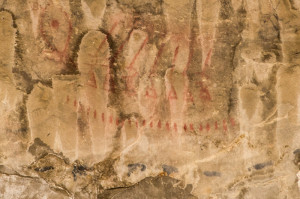 There are actually two caves at Pictograph State Park: the Pictograph Cave and the Ghost Cave. The trail guide details twenty-five points of interest and historical antidotes along the way. An interpretive plaque at the entrance of the Pictograph Cave helps you locate red paintings on the wall. Although the paintings are understandably faded, you can definitely still make out images of bison, rifles, and weird crying babies flying on balloons.
There are actually two caves at Pictograph State Park: the Pictograph Cave and the Ghost Cave. The trail guide details twenty-five points of interest and historical antidotes along the way. An interpretive plaque at the entrance of the Pictograph Cave helps you locate red paintings on the wall. Although the paintings are understandably faded, you can definitely still make out images of bison, rifles, and weird crying babies flying on balloons.
 Archaeological digs have indicated that the Ghost Cave, which features creepy, protruding boulders that sort of look like ghosts, was inhabited between 200 and 500 years ago. The Crow Tribe of Native Americans referred to this area “Alahpalaaxwaalaatuua,” which is a mouthful and literally translates to “where there is ghost writing.”
Archaeological digs have indicated that the Ghost Cave, which features creepy, protruding boulders that sort of look like ghosts, was inhabited between 200 and 500 years ago. The Crow Tribe of Native Americans referred to this area “Alahpalaaxwaalaatuua,” which is a mouthful and literally translates to “where there is ghost writing.”
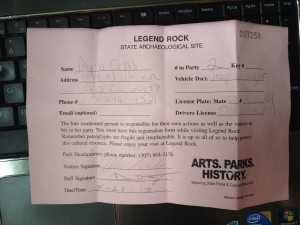 I checked out my first petroglyphs at Legend Rock outside of Thermopolis, Wyoming. Legend Rock is a 400-meter long cliff with more than 92 prehistoric petroglyph panels and over 300 carved figures. The informational brochures say that the carvings were made over the course of time between 11,000 to 100 years ago.
I checked out my first petroglyphs at Legend Rock outside of Thermopolis, Wyoming. Legend Rock is a 400-meter long cliff with more than 92 prehistoric petroglyph panels and over 300 carved figures. The informational brochures say that the carvings were made over the course of time between 11,000 to 100 years ago.
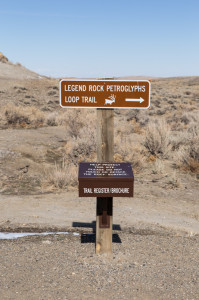 Now, you’re getting an inside tip because Wyoming doesn’t exactly advertise this state park. To visit the petroglyph site, you have to fill out a registration form at the Hot Springs State Park or the Thermopolis Chamber of Commerce, where you rent out an actual key. You actually have to get out of your car and unlock a huge gate to get into the park. And you’ll likely have the park all to yourself while you’re there too.
Now, you’re getting an inside tip because Wyoming doesn’t exactly advertise this state park. To visit the petroglyph site, you have to fill out a registration form at the Hot Springs State Park or the Thermopolis Chamber of Commerce, where you rent out an actual key. You actually have to get out of your car and unlock a huge gate to get into the park. And you’ll likely have the park all to yourself while you’re there too.
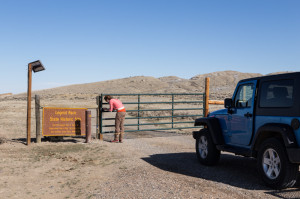 The interpretive trail brochure that you pick up with the key provides diagrams and descriptions of what you’re supposed to see at each marker. Since petroglyphs are carved into the rock, they’re much easier to see than their painted counterparts. A variety of anthromorphs and zoomorphs line the cliff walls, often depicting creatures with far too many heads and arms. There are fifteen markers along the cliff, which are spaced closely together along a dirt walking path.
The interpretive trail brochure that you pick up with the key provides diagrams and descriptions of what you’re supposed to see at each marker. Since petroglyphs are carved into the rock, they’re much easier to see than their painted counterparts. A variety of anthromorphs and zoomorphs line the cliff walls, often depicting creatures with far too many heads and arms. There are fifteen markers along the cliff, which are spaced closely together along a dirt walking path.
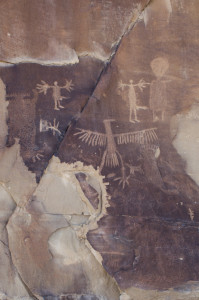 While making your way from one marker to the next, you can’t help but notice more “recent additions” on the cliff wall. In 1989, a small turtle was carved near Marker #12. The initials W.H., R.H., and M.C., which represent people who died in World War I, can be found near Marker #14. A carving that reads, “No Trojans Allowed” was created by a high school student on a field trip near Marker #15. The state park pegs these recent additions as vandalism and graffiti. But are they really?
While making your way from one marker to the next, you can’t help but notice more “recent additions” on the cliff wall. In 1989, a small turtle was carved near Marker #12. The initials W.H., R.H., and M.C., which represent people who died in World War I, can be found near Marker #14. A carving that reads, “No Trojans Allowed” was created by a high school student on a field trip near Marker #15. The state park pegs these recent additions as vandalism and graffiti. But are they really?
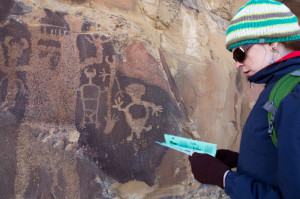 By definition, both petroglyphs and pictographs are vandalism and graffiti. People have been defacing rock structures for thousands of years, and after a certain amount of time, the graffiti is considered to be historical art.
By definition, both petroglyphs and pictographs are vandalism and graffiti. People have been defacing rock structures for thousands of years, and after a certain amount of time, the graffiti is considered to be historical art.
Where do you draw the line between cultural expression and kids being disrespectful? How many years must pass before “No Trojans Allowed” is considered a legitimate petroglyph?
And so the “Pictographs v. Petroglyphs v. Graffiti” debate continues…
